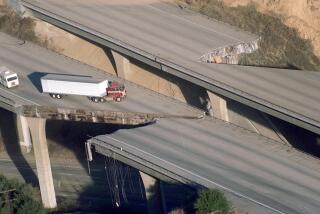Soviet Scientists Plan to Monitor Nevada A-Tests
- Share via
WASHINGTON — Soviet scientists are planning to install seismic equipment in the United States to monitor underground nuclear tests in Nevada under a privately arranged U.S.-Soviet effort, a private American environmental organization disclosed Monday.
The agreement, which appeared to catch the Reagan Administration by surprise, was announced in Moscow, where a team sponsored by the Natural Resources Defense Council has been installing seismic monitors near a Soviet nuclear test site.
Although the environmental group, along with Soviet scientists, said that plans call for installing similar equipment in this country by October, Pentagon officials said they were unaware of such an effort.
The U.S. government could thwart the agreement by denying the Soviet team visas or by prohibiting the Soviets from traveling to states near the Nevada nuclear test site. However, U.S. officials cooperated with the American team, expediting export licenses that allowed it to carry monitoring equipment for installation in the Soviet Union.
Officials at the White House and State Department, while expressing skepticism about the monitoring effort because it is being conducted on a private level and does not involve official delegations, indicated that they do not foresee any government effort to halt it.
Stan Norris, a senior research associate of the Natural Resources Defense Council, said that Reagan Administration permission would be required for the Soviet scientists to visit the Nevada test site to monitor the underground nuclear explosions.
While such approval is not expected, he said, the monitoring could instead be carried out at seismic stations maintained away from the test site by the Universities of California, Nevada and Colorado or on private land, if leases can be obtained.
“The seismologists must decide the best place to be,” he said.
The Key Issue
Monitoring, based on the movement of shock waves through the earth, provides data on the size of a blast and adherence to treaties limiting the yield of such explosions. The ability to measure the tests has been a key issue in efforts to reach agreement on new nuclear arms limits.
Thomas Cochran, who led the U.S. team visiting the Soviet Union, said at a news conference in Moscow that the U.S. scientists are installing equipment near the main Soviet test site of Semipalatinsk in the Central Asian Republic of Kazakhstan.
At the same session, Yevgeny P. Velikhov, vice president of the Soviet Academy of Sciences, said Soviet authorities have agreed to allow Soviet scientists to cooperate with the American group, on a non-governmental basis, Reuters news agency reported.
Jacob Scherr, the organization’s senior staff attorney, said in Washington, “Our goal is to have all . . . seismological sites (in the United States and Soviet Union) fully installed and operated by October.” They would be in operation for a year.
The exchange appears to be in the spirit of a proposal made in March by President Reagan, who renewed an invitation to Soviet leader Mikhail S. Gorbachev to send representatives to monitor a U.S. nuclear explosion.
Soviet Test Moratorium
The invitation has never been accepted. Instead, the Soviet Union proposed that the United States join it a moratorium on nuclear testing, which began last Aug. 6, the 40th anniversary of the dropping of an atomic bomb on the Japanese city of Hiroshima.
The United States has continued its program of frequent tests, maintaining that the Soviet Union had completed a series of tests before it announced the halt in experiments. At the same time, the Reagan Administration has maintained that because the United States relies on nuclear weapons to deter attack, it must make sure they work.
“You have to do that by having tests,” Defense Secretary Caspar W. Weinberger has said.
However, the United States and the Soviet Union have agreed in principle to discuss broad issues relating to underground nuclear tests, including U.S. efforts to improve monitoring of limits set in a 1974 treaty, as well as Gorbachev’s call for a ban on future nuclear weapons explosions. The forum for those discussions has not been decided.
Times staff writer Laralyn Sasaki contributed to this report.
The U.S. tentatively approves special SALT meeting. Page 15.
More to Read
Sign up for Essential California
The most important California stories and recommendations in your inbox every morning.
You may occasionally receive promotional content from the Los Angeles Times.












